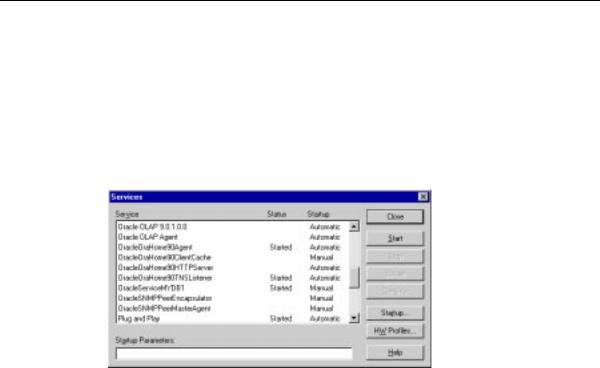
СУБД Oracle / Литература / Oracle 9.0.1 / A90163_01
.pdf
7
Oracle9i Services on Windows
This chapter describes Windows services in general and Oracle9i Database Windows services in particular.
This chapter contains these topics:
■
■
■
Introduction to Oracle9i Services
Oracle9i Services Available on Windows
Using Oracle9i Services
Oracle9i Services on Windows 7-1

Introduction to Oracle9i Services
Introduction to Oracle9i Services
Oracle9i starts each instance as a service on Windows. A service is an executable process registered in the Windows registry and administered by Windows. The registry automatically tracks and records security information for each service created.
Oracle also uses services, similar to Windows services, to provide support for its operations. Oracle services are created during the database creation process and are associated with the Oracle database. They are used to create, connect to, and use an Oracle instance.
Services simplify the process of starting up the database. The database can be configured to come up automatically when the computer is restarted, with no user interaction. Another advantage of services is that they can start with a specified user privilege.
Services start background processes, similar to the daemon processes on UNIX. When the Oracle database service starts, there is no typical Oracle thread running in the process. Instead, the process waits for the first connection from SQL*Plus. This causes a foreground thread to start and creates the background threads of the
System Global Area.
When the database is shut down, all the threads that were created are terminated. But the process itself continues, waiting for the next connection request and startup command.
Finally, the Oracle Net Listener is a service. This service needs to run before users can connect to the database. This process does not affect how clients connect to or use the database.
Oracle9i Services Available on Windows
Services are started manually or they can be set to start automatically when the computer is restarted. By default, services run under the system user. However, system is not a user that can create a logon session; rather, it is an operating system session for running system services.
The following are some of the services available on Windows. You may have additional services, depending on the components you installed.
Oracle Object Service
Used by Oracle Object Link Manager to synchronize symbolic link naming to logical volume mapping automatically on all the nodes in a cluster.
7-2 Oracle9i Database Getting Started

Oracle9i Services Available on Windows
Oracle OLAP Agent
The back end for Oracle OLAP Instance Manager. Performs the tasks specified in Instance Manager, such as starting and stopping an OLAP service or changing its configuration settings. Oracle OLAP Agent also returns information from the operating system, such as the success or failure of a startup attempt.
Oracle OLAP 9.0.1.0.0
The default OLAP service. Supports a calculation engine and multidimensional analytic workspaces for analytical applications. Performs complex statistical, mathematical, and financial calculations along with predictive analysis functions such as forecasting, modeling, consolidations, allocations, and scenario management.
OracleCMService9i
Used for the Cluster Manager for Oracle Real Application Clusters.
OracleDirectoryService_SID
Responsible for starting and shutting down all Oracle Internet Directory (OID) servers (oidldapd, oidrepld, and oidmetad). Also monitors all OID servers once they are up and running. If an OID server goes down, then OracleDirectoryService_SID restarts it.
OracleEXTPRC
Used for external naming methods (Novell Directory Services and Network Information Service).
OracleGSDService
The Global Services Daemon (GSD) receives requests from SRVCTL to execute an administrative job task, such as startup or shutdown. The task is executed locally on all nodes, and the results are sent back to SRVCTL. This service is installed with Real Application Clusters.
OracleHOME_NAMEAgent
Part of the Oracle Enterprise Manager product suite. Intelligent Agent is required for the execution of jobs and performance monitoring of Oracle services or targets such as listeners, databases, Oracle HTTP Server powered by Apache, and Oracle Applications. Intelligent Agent also collects statistical data for Capacity Planner and
Oracle9i Services on Windows 7-3

Oracle9i Services Available on Windows
Performance Manager, which are data-collecting applications available in the Oracle Diagnostics Pack.
OracleHOME_NAMEClientCache
Used for the Client Cache Service, a networking product.
OracleHOME_NAMECMAdmin
Performs administrative functions, including answering requests sent from the Oracle Connection Manager Control utility, monitoring registered listeners, and communicating address information to Oracle Names servers.
OracleHOME_NAMECMan
Listens for incoming client connection requests. It also provides session multiplexing, access control, and protocol conversion functions.
OracleHOME_NAMEHTTPServer
Starts the Oracle HTTP Server powered by Apache. Used as the Web server with browser-based Oracle Enterprise Manager.
OracleHOME_NAMEManagementServer
Management Server is the middle tier of Oracle Enterprise Manager. It maintains centralized intelligence and distributed control between clients and managed nodes.
OracleHOME_NAMEPagingServer
Oracle Enterprise Manager Paging Server allows Enterprise Manager administrators to receive paging notifications concerning registered events and scheduled jobs.
OracleHOME_NAMETNSListener
Listens for and accepts incoming connection requests from client applications. Automatically starts when the Windows computer restarts. If it is not started, then the following error message appears when attempting to connect with username/password@net_service_name:
ORA-12541 TNS: no listener
7-4 Oracle9i Database Getting Started

Oracle9i Services Available on Windows
OracleMSCSService
Created and configured during the installation of Oracle Fail Safe and Oracle Real Application Clusters Guard. Required on all Windows clusters nodes where these components are installed. OracleMSCSService is under the control of Microsoft Cluster Server and should be set to manual startup.
Oracle Fail Safe and Oracle Real Applications Clusters Guard are planned to ship in a subsequent CD pack.
OracleMTSRecoveryService
Helps Oracle databases recover in-doubt Oracle transactions that were started on behalf of Microsoft Transaction Server (MTS) transactions originating from Windows NT and Windows 2000 computers. There is only one such service for each Windows NT or Windows 2000 computer having Oracle Services for MTS installed.
OracleNAMES
Used for the distributed naming service developed for Oracle environments.
OracleServiceSID
Created for the database instance system identifier, where SID is the value you entered for the database name during Oracle9i installation. This service is mandatory. If is it not started, then the following ORA-12560 error message appears when you attempt to use any of the Oracle9i Utilities, such as SQL*Plus:
ORA-12560 TNS: protocol adapter error
OracleSNMPPeerEncapsulator
See OracleSNMPPeerMasterAgent. The Encapsulator is only required when you have more than one SNMP sub-agent installed and configured on the system.
OracleSNMPPeerMasterAgent
Simple Network Management Protocol (SNMP) is a standard internet protocol enabling certain nodes in a network to query other network components or applications for information concerning their status and activities. All requests sent to a given network node are handled by the same Master Agent, which redirects the requests to the appropriate managed elements on the node, in some cases using subagents.
Oracle9i Services on Windows 7-5

Using Oracle9i Services
OraFenceService
A kernel mode service to provide I/O fencing. Reboots a node in case the node hangs in kernel mode for a defined amount of time. The service is installed on all nodes with OracleCMService9i.
Using Oracle9i Services
Oracle services appear in the Services dialog box of the Control Panel:
All Oracle services begin with "Ora". Use the Services dialog box to start or stop each of the Oracle services available on the computer.
The services are found in the registry under: HKEY_LOCAL_
MACHINE\SYSTEM\CURRENTCONTROLSET\SERVICES.
See Also:
■
■
Chapter 6, "Multiple Oracle Homes and Optimal Flexible Architecture" in this manual for information on multiple, active Oracle home directories on a single computer, which affects the naming conventions for Oracle services
"Administering a Database", in Oracle9i Database Administrator’s Guide for Windows for details on managing Oracle services
7-6 Oracle9i Database Getting Started

8
Oracle9i Default Accounts and Passwords
This chapter describes the Oracle9i Database default accounts and passwords. This chapter contains these topics:
■Overview
■Unlocking and Changing Passwords
■Granting Limited SYS Database Role Privileges
■Reviewing Accounts and Passwords
Oracle9i Default Accounts and Passwords 8-1

Overview
Overview
Oracle9i installs with a number of default accounts. The Oracle Database Configuration Assistant locks and expires all default database accounts upon successful installation with the following exceptions:
■
■
■
■
■
■
■
■
SYS
SYSTEM
SCOTT
DBSNMP
OUTLN AURORA$ORB$UNAUTHENTICATED AURORA$JIS$UTILITY$ OSE$HTTP$ADMIN
You must unlock all other accounts before using them. Oracle Corporation recommends changing all user passwords immediately after installation.
Important: If installing Oracle Internet Directory, then change the passwords for SYS and SYSTEM only after the Oracle Internet Directory installation is complete.
At a minimum, the Oracle Database Configuration Assistant creates the SYS, SYSTEM, and DBSNMP accounts in all databases. Additional accounts are created depending on the components installed. Unlock accounts and change passwords before using them. Table 8–2 describes the accounts and passwords.
See Also:
■
■
Oracle9i Database Administrator’s Guide for Windows for information on Oracle security procedures and security best practices
Oracle Enterprise Manager Administrator’s Guide for information on security management
8-2 Oracle9i Database Getting Started

Unlocking and Changing Passwords
Unlocking and Changing Passwords
At the end of installation, several configuration assistants automatically start to create and configure your database and network environments. One such assistant is the Oracle Database Configuration Assistant, which automatically prompts you to change passwords and unlock accounts immediately after installation.
To change a password during the database installation and configuration process:
1.From the Oracle Database Configuration Assistant window, choose the Password Management button.
Note: The Password Management button is not available when using Oracle Database Configuration Assistant as a standalone tool (that is, after the installation and configuration process is complete).
2.Select a username and clear the check mark.
3.Enter a new password and confirm the new password for each username.
Note: If you unlock a password, but do not specify a new password, then the password is expired until the next time you access that account.
Alternatively, use SQL*Plus to unlock accounts and change passwords any time after the installation process.
To change a password after installation:
1.Start SQL*Plus:
C:\> SQLPLUS /NOLOG
2.Connect as SYSDBA:
SQL> CONNECT / AS SYSDBA
3.Change the password according to the SQL commands indicated in Table 8–1:
Oracle9i Default Accounts and Passwords 8-3

Granting Limited SYS Database Role Privileges
Table 8–1 SQL Statements for Administering Accounts and Passwords
Action |
SQL Statement |
|
|
Unlock a password |
ALTER USER username ACCOUNT UNLOCK; |
Lock a password |
ALTER USER username ACCOUNT LOCK; |
Change the password of an unlocked |
ALTER USER username IDENTIFIED BY |
account |
password; |
Change the password of a locked |
ALTER USER username ACCOUNT IDENTIFIED |
account |
BY password ACCOUNT UNLOCK; |
|
|
Granting Limited SYS Database Role Privileges
Any database user can be granted a limited SYS database role privilege to use the Oracle Enterprise Manager Diagnostic Pack. Grant users access to these necessary SYS privileges by granting the OEM_MONITOR role. This role is created when the database is installed and is defined in the SQL script at \ORACLE_BASE\ORACLE_ HOME\rdbms\admin\catsnmp.sql.
See Also: Oracle9i SQL Reference for information on the GRANT statement
Reviewing Accounts and Passwords
Table 8–2 lists Oracle9i default accounts and passwords. It also briefly describes the purpose of each username and shows where to find additional information.
Table 8–2 Oracle9i Default Accounts and Passwords
Username |
Password |
Description |
More Information |
|
|
|
|
SYSTEM1 |
MANAGER |
Used for performing database administration |
Oracle9i Database |
|
|
tasks. SYSTEM includes the AQ_ |
Administrator’s Guide |
|
|
ADMINISTRATOR_ROLE and DBA database |
|
|
|
roles. |
|
|
|
|
|
SYS2 |
CHANGE_ON_ |
Used for performing database administration |
Oracle9i Database |
|
INSTALL3 |
tasks. |
Administrator’s Guide |
|
|
|
|
AURORA$JIS$UTIL Randomly |
Used internally by Enterprise Java Beans and |
Not applicable |
|
ITY$ |
assigned at |
CORBA Tools. Log on as SYS to change the |
|
|
installation |
password for this username. |
|
|
|
|
|
8-4 Oracle9i Database Getting Started
